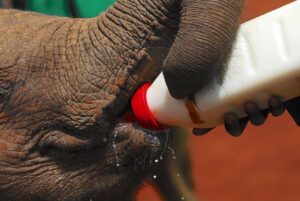COVID-19 offers us a chance to rethink elephant tourism
 12 Agustus 2020
12 Agustus 2020
For the first time in recent memory, the world has slowed down and humanity has a chance to reflect on the way we’ve been doing things and how we can improve in the future – for both humans and wildlife.
Nature reserves and businesses that offer wildlife experiences would usually be booming this time of year, but not now. The COVID-19 pandemic has created an unprecedented pause for the travel industry in particular.
Trunks & Leaves, our nonprofit focused on the conservation of Asian elephants, believes that wildlife tourism is fueled largely by people’s love of animals, and when done responsibly, it can provide huge benefits by financing the maintenance of protected areas and supporting livelihoods while paying for the conservation and upkeep of endangered species in human care that cannot be released into the wild.
Done wrong, however, it can also contribute to the demise of a species, especially when it comes to the much-beloved but often-exploited Asian elephant.
Asian elephants are believed to number between 40,000 and 50,000 globally, which means they are 10 times more endangered than their African counterparts. When most people think of Asian elephants, they think of countries like Thailand where it is possible to view and even interact with the animals up close in fairly controlled settings. Others may think of places like India and Sri Lanka, where wild elephants are among the big draws at national parks.
But what are the best ways to view elephants in these settings? What does being responsible really mean?
Straightforward guidance has unfortunately been lacking. Additionally, while there are many advocacy organizations focused on the welfare of captive elephants, few have addressed the conservation issues raised by tourism. Our Ethical Elephant Experiences guidelines seek to provide answers to these commonly asked questions and encourage travelers and travel companies alike to make responsible decisions.
The dangers of hands-on experiences
It’s become a dream of many people to touch, bathe and feed elephants. While these experiences are often viewed as “life-changing,” few people consider the impacts they can have on the elephants themselves.
In situations where captive elephants have the opportunity to mingle with wild elephants (such as for breeding), contact with visitors and human caretakers who have contact with visitors creates an opportunity for the transfer of novel diseases and pathogens that could easily infect and decimate wild elephant numbers.

Young calves, especially those that originated in the wild but were orphaned, have the best chance of being rehabilitated and released back into the wild. However, experience has shown that baby Asian elephants will not be able to become fully independent in the wild if they are heavily socialized with humans.
Hands-on experiences with baby elephants, such as bottle feeding and playing with humans, means that they will never be releasable.
Such situations also create a perpetual demand for babies, and thus for captive elephants, incentivizing the continued breeding of elephants for a life of servitude.
Baby elephants eventually grow up, and can live for over 60 years. As long as babies are in demand, this will continue to perpetuate an industry that profits from captive elephants under the guise of serving animal welfare.
More importantly, since captive elephant populations to date are not viable, the question arises how these facilities and industry as a whole can survive without a periodic influx from wild populations.
Feeding wild animals escalates human-elephant conflicts
All elephants, wild or captive, should be viewed at a distance with a clear separation between people and animals. Animals should be allowed to engage in natural behavior without human guidance or direction for the benefit of tourists.
Some people are tempted to feed animals, attracting them closer for photo ops. This seemingly innocuous act can actually be extremely detrimental to their health and safety. Feeding wild elephants encourages them to become dependent on human hand-outs. The high-calorie items they are fed, often sweet things like fruit, may be far more preferable to natural foliage.
As a result, some animals become a nuisance, willfully obstructing traffic on roads to demand food from passers-by. Others might eventually become crop or home raiders, severely escalating human-elephant conflicts and forcing authorities to implement control measures that ultimately harm the animal.
The dangers of social media
In this digital age, social media is becoming ever more influential and powerful. A single photo can inspire people to add a destination or experience to their bucket list. Unfortunately, it’s become far too common a practice for people to manipulate their images, for instance by editing out fences or barriers in their photos with elephants, making it appear that they are standing closer to the animal.
This is especially problematic with people who have a large following, such as influencers and bloggers. These viral photos creating unrealistic expectations have the power to inspire others to partake in dangerous and irresponsible activities, like approaching a wild elephant on foot. If such a close encounter results in the injury or death of a person, authorities would likely be forced to destroy the animal as well.
We have the opportunity to use this unprecedented pause in tourism to work toward a better future for elephants. When borders reopen and travel resumes, Trunks & Leaves hopes to inspire and empower people to make responsible and ethical choices moving forward.
The post COVID-19 offers us a chance to rethink elephant tourism appeared first on Sustainability Times.
